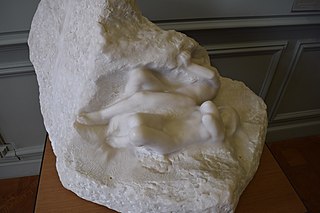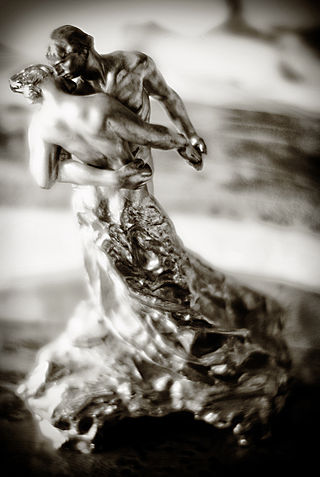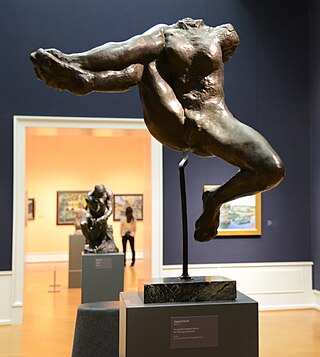
François Auguste René Rodin was a French sculptor, generally considered the founder of modern sculpture. He was schooled traditionally and took a craftsman-like approach to his work. Rodin possessed a unique ability to model a complex, turbulent, and deeply pocketed surface in clay. He is known for such sculptures as The Thinker, Monument to Balzac, The Kiss, The Burghers of Calais, and The Gates of Hell.

Berthe Marie Pauline Morisot was a French painter and a member of the circle of painters in Paris who became known as the Impressionists.

The Thinker is a bronze sculpture by Auguste Rodin, usually placed on a stone pedestal. The work depicts a nude male figure of heroic size sitting on a rock. He is seen leaning over, his right elbow placed on his left thigh, holding the weight of his chin on the back of his right hand. The pose is one of deep thought and contemplation, and the statue is often used as an image to represent philosophy.

The Musée Rodin in Paris, France, is an art museum that was opened in 1919, primarily dedicated to the works of the French sculptor Auguste Rodin. It has two sites: the Hôtel Biron and surrounding grounds in central Paris, as well as just outside Paris at Rodin's old home, the Villa des Brillants at Meudon, Hauts-de-Seine. The collection includes 6,600 sculptures, 8,000 drawings, 8,000 old photographs and 7,000 objets d'art. The museum receives 700,000 visitors annually.

The Gates of Hell is a monumental bronze sculptural group work by French artist Auguste Rodin that depicts a scene from the Inferno, the first section of Dante Alighieri's Divine Comedy. It stands at 6 metres high, 4 metres wide and 1 metre deep (19.7×13.1×3.3 ft) and contains 180 figures.

The Mature Age, also named Destiny, The Path of Life or Fatality (1894–1900) is a sculpture by French artist Camille Claudel. The work was commissioned by the French government in 1895, but the commission was cancelled in 1899 before a bronze was cast. A plaster version of the sculpture was exhibited in 1899, and then cast in bronze privately in 1902. A second private bronze casting was made in 1913, and it is thought that the plaster version was destroyed at that time.

Cybele is a sculpture by French artist Auguste Rodin. It is one of the first of Rodin's partial figures known as "fragments" to be displayed as sculpture in its own right, rather than an incomplete study.

Eternal Springtime is a c. 1884 sculpture by the French artist Auguste Rodin, depicting a pair of lovers. It was created at the same time as The Gates of Hell and originally intended to be part of it. One of its rare 19th-century original casts belongs to the permanent collection of Calouste Gulbenkian Museum.

Eve is a nude sculpture by the French artist Auguste Rodin. It shows Eve despairing after the Fall.

Despair or Despair at the Gate is a sculpture by Auguste Rodin that he conceived and developed from the early 1880s to c. 1890 as part of his The Gates of Hell project. The figure belongs to a company of damned souls found in the nine circles of Hell described by Dante in The Divine Comedy. Other title variations are Shade Holding her Foot, Woman Holding Her Foot, and Desperation. There are numerous versions of this work executed as both plaster and bronze casts and carved marble and limestone.

Meditation or The Interior Voice is an 1886 sculpture by Auguste Rodin, showing a young woman resting her head on her right shoulder.

Adam and Eve or Adam and Eve Sleeping is a 1905 marble sculpture by Auguste Rodin. It is located in the Musee Rodin in France.

Adam is an 1880-1881 statue of Adam by Auguste Rodin, first exhibited at the Paris Salon that year entitled The Creation of Man.

The Waltz or The Waltzers is a sculpture by French artist Camille Claudel. It depicts two figures, a man and a woman, locked in an amorous embrace as they dance a waltz. The work was inspired by Claudel's burgeoning love affair with her mentor and employer Auguste Rodin. Various versions were made from 1889 to 1905, initially modelled in plaster, and later cast in bronze. Examples are held by the Musée Rodin and the Musée Camille Claudel.

The Bust of Auguste Rodin was sculpted by the French artist Camille Claudel in 1888-1889 as a tribute to her teacher and lover, Auguste Rodin.

Sakuntala, also known as Sakountala or Çacountala, is a sculpture by the French artist Camille Claudel, made in several versions in different media from 1886, with a marble version completed in 1905, and bronze castings made from 1905. The sculpture depicts a young couple, with a kneeling man embracing a woman leaning towards him. It was named after the play Shakuntala by the 4th-5th century Indian poet Kālidāsa, and is inspired by the moment when the title character Shakuntala is reunited with her husband Dushyanta after a long separation.

Iris, Messenger of the Gods is a bronze sculpture by Auguste Rodin. A plaster model, created between 1891 and 1894, was cast in bronze by Fonderie Rudier at various times from about 1895. Iris is depicted with her right hand clasping her right foot and her naked body posed provocatively with her legs spread wide, displaying her genitalia.

Rose Beuret (born Marie Rose Beuret; 9 June, 1844 in Vecqueville and died on 14 February, 1917 in Meudon, was a French seamstress and laundress, known to have been one of the muses and, for 53 years, the companion of Auguste Rodin, whom she married just weeks before her death in 1917.


















